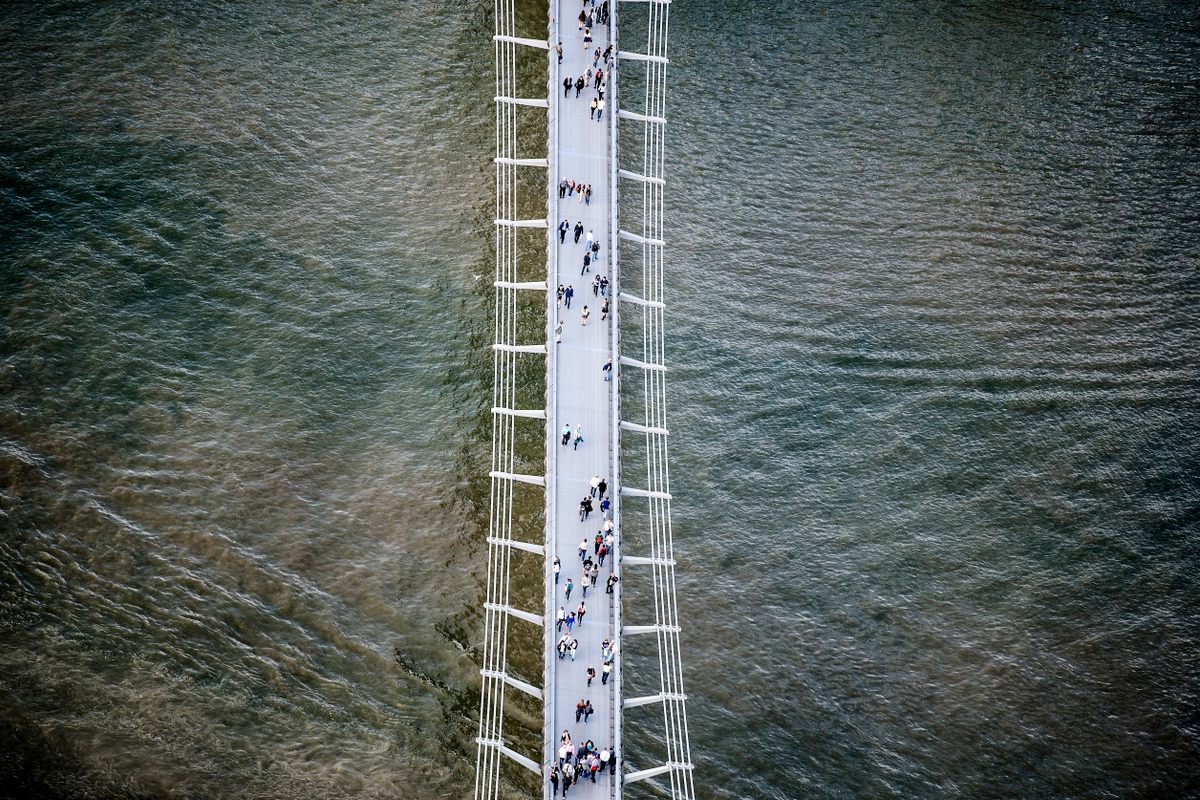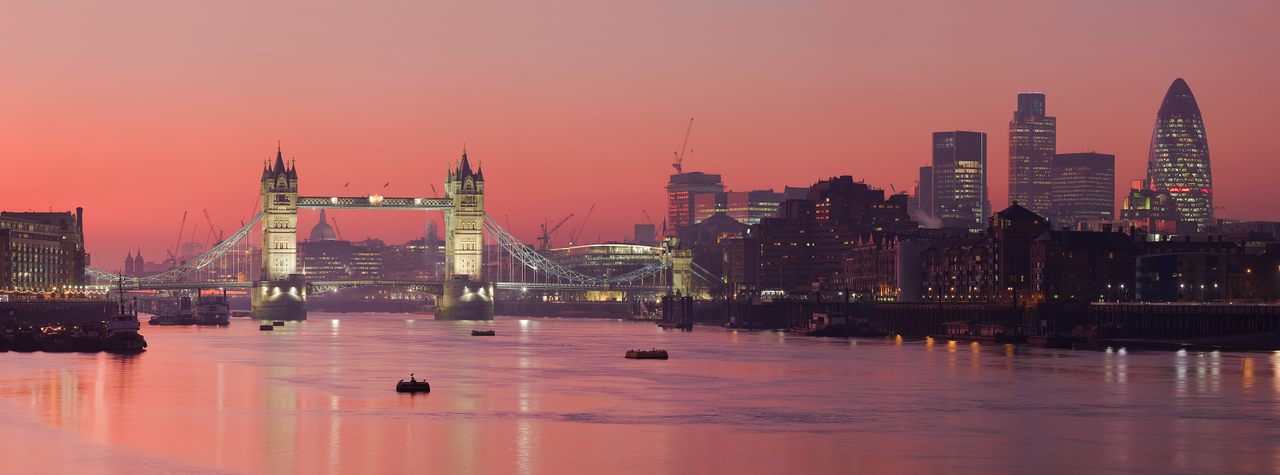How The Thames, Once a ‘Zombie River,’ Was Brought Back to Life
Sharks, beavers, and humans are all returning to London’s iconic waterway thanks to decades of restoration work.
This piece was originally published in Slate and appears here as part of our Climate Desk collaboration.
Around 200 years ago, during the Industrial Revolution, London’s River Thames was both a hub of trade and transport and a dumping ground for human excretion and industrial waste. The cradle of England’s industrial heritage was quickly becoming a glorified sewer. The stench was so unbearable during the sweltering summer of 1858 that it forced some government offices on the riverbank to close. That summer earned the nickname “the Great Stink.”
The Great Stink never garnered the notoriety of London’s Great Fire or Great Plague, although we can at least thank the stench for inspiring the invention of the modern sewage system. But the Thames didn’t hit rock bottom until 1957, when the city’s Natural History Museum declared the river “biologically dead.” Wildlife that hadn’t fled were expiring in the water. On the Thames, The Guardian would write two years later, “people were living near and working on what was to all intents and purposes an open sewer.”

This past November, a health checkup by the Zoological Society of London revealed what the group hadn’t seen in the River Thames for more than 60 years: promising signs of life. Hundreds of species, including 115 types of fish, 6-foot sharks, seahorses, eels, and the occasional stray whale now call the body home. The Thames—the River of Death, the zombie river—can finally shed its “biologically dead” label, according to the society’s report. The resurrection has brought benefits both to the creatures who dwell within it and the ones who live, work, and play on its banks.
Cleanup efforts over the past few decades are largely to thank for the Thames’ new chance at biological life. New water management has significantly reduced phosphorus concentrations since the 1990s. Dissolved oxygen levels, which are critical for the survival of many aquatic animals, have shown some short-term improvements. And the century-old sewage system is getting an upgrade with a new 4.2-million-pound (roughly $5 million), 25-kilometer (about 15.5 miles) “super sewer.” “The river was pretty bad for the last 200 years, but being declared biologically dead by the Natural History Museum was a low point,” says Alison Debney, a marine and freshwater conservation program manager at the Zoological Society. “There are so many services that nature provides us that would support life if we just allow it to do so.”
We’ve been bringing rivers back from the dead for a few decades now. Beijing’s Yongding River was left out to dry in 1992. Today, the river’s ecosystem is being revived with reclaimed water from sewage plants, updated drainage and flood management systems, and new parklands stitched into the riversides. New York City is reviving the Tibbetts Brook in the Bronx, a hidden waterway buried more than a century ago near the Major Deegan Expressway. The resurrection is part of the city’s master plan for Van Cortlandt Park to create more green spaces and manage the city’s flood risks. The Los Angeles River was once a volatile waterway and critical water source running through the center of the city. Now, it’s a narrow stream with manmade, concrete channels that has primarily been used as a waste dumping site since the 1940s. All hopes of resuscitating it were almost lost when there were talks of paving it over and turning it into a freeway in the 1980s. But a team led by the L.A. County Public Works Department is calling to not only restore (what’s left of) the river’s ecosystem but also to use the river as a vehicle for economic recovery by creating jobs and revamping the riverbank as a public resource. But as zombie rivers go, the Thames is arguably the most famous of the bunch.

The problem with the Thames (along with many of these zombie rivers) is that it was not only dead, but lost from the collective imagination. After World War II, the main attractions along the riverbanks were bomb-damaged buildings and defunct warehouses. Apartments that were once elbowing one another for riverside views started building their frontages facing away from the river. Shipyards closed their doors, which left many city dwellers without jobs and turned prosperous industrial zones into distressed neighborhoods. River restoration isn’t just about making space for river life, but revamping the life and culture the river once embodied.
The nice part about the Thames is there’s a lot of space on it—it’s about 750 feet wide at London Bridge. You won’t find room like that in the center of London, where the city has already introduced congestion charges. How else can you get locals out of cars and trucks besides fining them? Use the river. Transport for London, the organization that runs London’s transit system, is looking to double the number of trips on the river to 20 million by 2035. The main river bus service, the Thames Clipper, has been running since 1999, although recently it’s teamed up with Uber.
Beyond commuter foot traffic, the city is also hoping to revamp the river’s cargo transport infrastructure. London opened its first new shipyard in more than a century. The Port of London Authority is already buying up old wharves along the river, including the Peruvian Wharf, which was closed for more than 20 years. Royal Wharf Pier reopened in 2019 with a major facelift, including a 162-square-meter viewing platform overlooking the river.
London Mayor Sadiq Khan is looking to address the city’s housing shortage through its restoration plans near the riverbanks. The mayor invested nearly 6.8 million pounds (about $8.2 million) in 2018 to create affordable housing for hundreds of Londoners at the Royal Docks in east London, an area that once suffered from industrial decline. The homes will be 50 percent cheaper than local market rents and range from studios to four-bedrooms. The city also established tax breaks and other business incentives at the Royal Docks to encourage foreign investment and local job creation. About 8 billion pounds (around $9.7 billion) is being invested in the area over 20 years to revamp the docks, which cover 18.4 kilometers (about 11 miles) of waterfront. The hope is to create an attractive residential and international business district that reflects London’s industrial heritage in an area haunted by poverty and abandonment. While the fate of the Royal Docks is still in flux, some affordable housing residents have complained of segregation. Subsidized tenants were prohibited from using the luxury swimming pools, gyms, and clubhouse nearby while their private owner and renter neighbors had full access.

Not every restoration plan for the Thames is about creating shiny new buildings. Some are working with communities to improve local ecosystems outside the river that keep the Thames thriving—a task the river charity Thames21 has been working on. Sadly, the same report that outlined the Thames’ renewal also revealed that long-term water temperature and sea level rise means the river could fall prey to climate change. And the river has some of the highest microplastic counts of any river in the world.
Thames21 has been adding wetlands to parks and turning bland grassland with low recreational value into hubs of biodiversity. Even moving beavers back into London, after they were absent for 400 years, is part of the city’s rewilding scheme. Thames21 is also being creative in dealing with the city’s century-old sewage problem. “We try to work with local authorities and landowners to build sustainable drainage systems, anything to take the clean water out of the sewer and store it in people’s gardens, parks, and by roadsides,” says John Bryden, a senior program manager at Thames21. “Those rain gardens create really nice diverse habitats in themselves and great ways for communities to engage with nature at their doorstep.”
Plans to create a riverfront renaissance of art and culture along the banks have also been drafted. Riverside cultural venues, architectural and wildlife tours, and better public walking and cycling connections alongside the river are all among the city’s ambitions. Construction is underway to extend the Thames Path, a public walking trail that currently stops at London’s Thames Estuary, to the English Coast.
The River Thames was once a highly depressed, brown, opaque fluid, a victim of industrial exploitation and human waste. Today, it’s still brownish and opaque, and it probably always will be—largely because the tides churn up mud from the bottom of the river every day. But at least now if you sit along the bank, or walk, or run, or take a ride on the river, you’ll know you’re in good company. And it smells just fine.

























Follow us on Twitter to get the latest on the world's hidden wonders.
Like us on Facebook to get the latest on the world's hidden wonders.
Follow us on Twitter Like us on Facebook